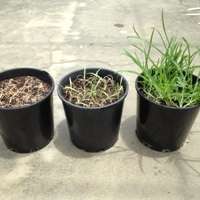Weed scientists to iron out farmers' frowns with assault on crowsfoot grass

Rubber, cotton, rice, palm oil, bananas, other fruits and vegetables - these are just some of the crops under threat from a weed that has recently developed resistance to some of the most powerful chemicals.
Scientists at The University of Western Australia are teaming with researchers at the German pharmaceutical and chemical company Bayer to understand the molecular and biochemical mechanisms which give the pantropical crowsfoot grass (Eleusine indica) the ability to resist potent weedkillers including glyphosate and glufosinate.
Director of the UWA-based Australian Herbicide Resistance Initiative, Winthrop Professor Stephen Powles, and his team have a grant of almost $400,000 over three years from the Australian Research Council to undertake the research.
Professor Powles said with the global population predicted to grow by at least 25 per cent by 2050, the need for sustainable production of food was critical for human and environmental health.
It was crucial for scientists to identify the exquisite details of how weeds develop resistance to herbicides, he said. Crowsfoot grass had developed resistance very fast and the team will endeavour to determine how it has happened.
Team-member Research Associate Professor Qin Yu said the first step was to check the herbicide target enzyme to see if any gene mutations were occurring. Another way of doing this was to treat the leaves with radioactive-labelled herbicide and watch (as in an X-ray) its progression through the plant, using herbicide susceptible plants as a comparison.
"We'll be also able to determine if the herbicide remains intact in the plant, or if it gets broken down faster in the resistant than susceptible plants," Professor Yu said.
The professors are co-supervisors of PhD student Adam Jalaludin who is spending four months at Bayer in Germany.
They used the analogy of a ball, a bat and a baseball glove to explain how herbicide works - and how it might be resisted. The ball is the herbicide and the glove is the target enzyme in the plant into which it fits. But if the plant develops resistance over generations, the enzyme is altered due to target-site gene mutations and the ball no longer slots into it. However, another way resistance works is when the plant uses a 'bat' to deflect the ball.
Professor Powles said until scientists could overcome resistance in weeds, farmers around the world needed to use restraint when using herbicides, use different chemicals from time to time, and try other methods of weed control such as the new Weed Seed Destructor.
"Herbicides, like antibiotics, are a precious resource," he said. "When on a good thing, don't stick to it!"
Provided by University of Western Australia
















